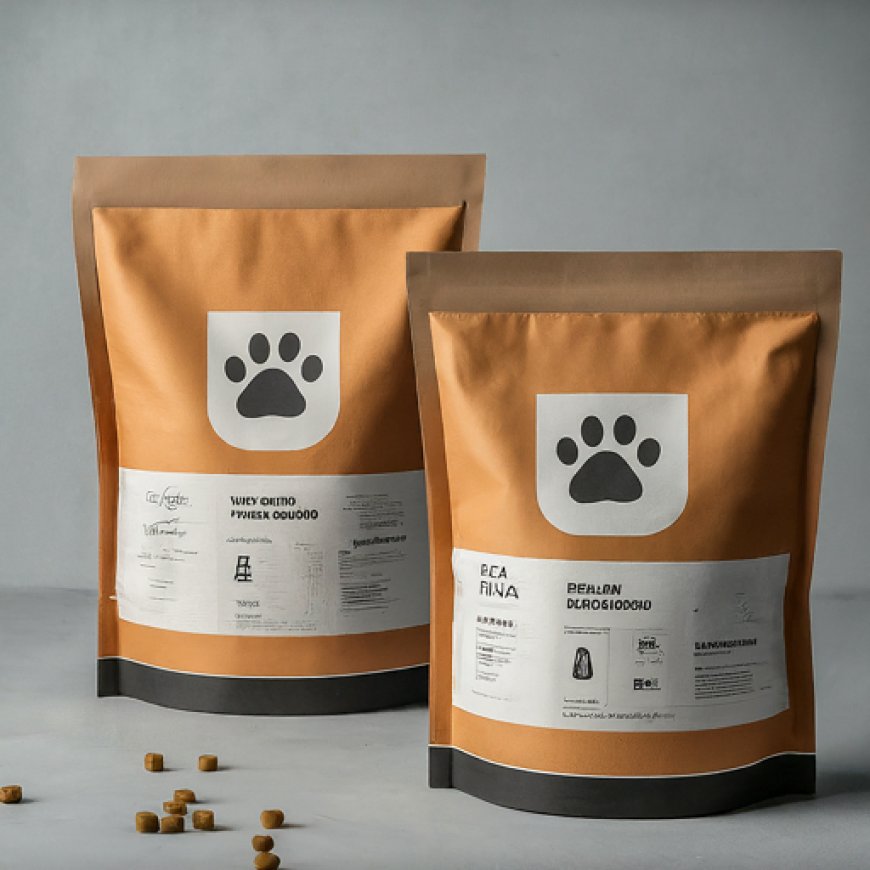Pet Food Packaging: Ensuring Freshness, Safety, and Convenience for Your Furry Friends
Pet food packaging preserves freshness, ensures safety, offers convenience, and supports eco-friendly solutions.

Pet food packaging is more than just a bag or a can that holds your pet’s meals. It plays a crucial role in keeping the food fresh, safe, and easy to store. From preserving flavors to protecting the nutritional value, good packaging ensures that your pets get the best out of their food. Let's explore the key aspects of pet food packaging and why it's so important.
1. Why is Pet Food Packaging Important?
The packaging of pet food is designed to:
-
Maintain Freshness: Proper sealing helps keep moisture, air, and contaminants out, preserving the flavor and nutritional value.
-
Ensure Safety: Food-grade materials prevent contamination or spoilage, keeping your pets healthy.
-
Convenience: Features like resealable zippers and easy-pour spouts make it easier for pet owners to handle and store food.
-
Sustainability: With increasing environmental awareness, many companies are now using eco-friendly materials, reducing plastic use, and making packaging recyclable.
2. Types of Pet Food Packaging
Different types of pet food, whether dry, wet, or treats, require specialized packaging to maintain their quality. Here are the most common types:
-
Bags: For dry kibble, pet food bags are often made of multi-layered materials to protect against moisture and pests. Many are now resealable to keep food fresh longer after opening.
-
Cans: Wet pet food is usually packed in metal cans, which provide an airtight seal to preserve freshness. These cans are highly durable and easy to stack, but they are single-use.
-
Pouches: Pouches are increasingly popular for both wet food and treats. They’re flexible, lightweight, and often resealable, which makes them convenient for pet owners.
-
Plastic Containers: Some pet food brands use plastic tubs or buckets for larger portions. They are durable, reusable, and often come with airtight lids to ensure long-term freshness.
3. Key Features of Good Pet Food Packaging
When choosing pet food packaging, both manufacturers and consumers look for certain qualities that add to the overall value:
-
Resealability: Keeping food fresh for longer is essential, especially for dry kibble. Resealable zippers or Velcro strips are common features.
-
Airtight Seals: For both dry and wet foods, an airtight seal helps to lock in freshness and prevent spoilage.
-
Portion Control: Some packaging offers pre-portioned servings or clear measurement indicators, making it easier for pet owners to feed the right amount.
-
Durability: Pet food packages need to withstand shipping, storage, and handling without breaking or tearing.
-
Eco-Friendliness: As sustainability becomes more important, eco-conscious pet owners are looking for recyclable, biodegradable, or reusable packaging options.
4. Sustainability in Pet Food Packaging
Many companies are now shifting towards more sustainable packaging solutions to reduce their environmental impact. This can include:
-
Recyclable Materials: Using plastics and materials that can be easily recycled after use.
-
Biodegradable Packaging: Some brands offer compostable or biodegradable packaging, reducing waste in landfills.
-
Reducing Plastic Use: Minimizing the use of plastic or replacing it with plant-based alternatives.
Consumers can also contribute by choosing brands that use sustainable packaging and properly recycling or reusing the containers.
5. How to Choose the Best Pet Food Packaging for Your Needs
Here are a few tips for selecting the right packaging:
-
Consider Your Pet’s Diet: Wet or dry food, treats, and supplements all require different packaging, so choose what best preserves the type of food you’re feeding.
-
Look for Convenience: Features like resealable zippers, handles, or easy-pour designs can make storing and serving food much easier.
-
Check for Durability: If you buy pet food in bulk, make sure the packaging is strong enough to handle long-term storage without leaking or tearing.
-
Think About the Environment: Opt for brands that use eco-friendly packaging, especially if you’re concerned about sustainability.
6. Future Trends in Pet Food Packaging
With advancements in technology and rising environmental concerns, the future of pet food packaging is evolving. Some exciting trends include:
-
Smart Packaging: QR codes and RFID tags on packages may offer detailed information about the food’s origin, nutritional value, and expiration date.
-
Improved Sustainability: Bioplastics, plant-based materials, and innovations in reusable packaging are set to become more prominent as brands focus on reducing their carbon footprint.
-
Personalized Packaging: More companies are offering customized packaging for pet owners who want portion-specific or breed-specific meals delivered straight to their doorsteps.
Conclusion
Pet food packaging plays a vital role in preserving the quality of the food you provide for your pets. With innovations in materials and design, packaging has evolved to meet the needs of both pets and owners. From resealable features to eco-friendly materials, understanding what makes good pet food packaging can help ensure your furry friend stays healthy, happy, and well-fed.
When choosing pet food, pay attention to packaging details—they might just make feeding time easier and more sustainable!












